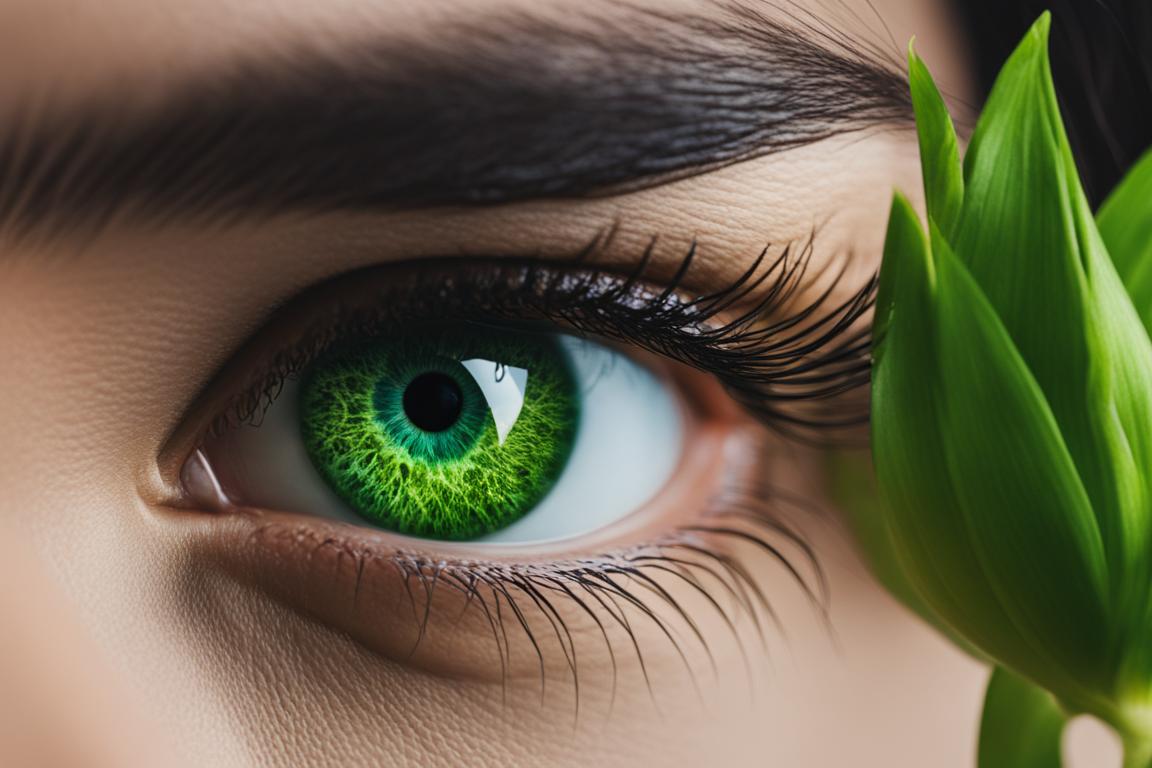Hello, fellow readers! Today, I’m excited to delve into the fascinating topic of CBG and its potential benefits for eye health. Your eyes are precious, and taking care of them should always be a priority. So, let’s explore how CBG, a compound found in cannabis plants, may contribute to better ocular health.
CBG, short for cannabigerol, has garnered attention for its possible therapeutic effects on various health conditions. While it’s important to note that CBG has not been medically proven to prevent, treat, or cure eye diseases, ongoing research suggests promising results in certain aspects of eye health.
So, let’s dive into the world of CBG and its potential benefits for our precious peepers!
Key Takeaways:
- CBG, a compound found in cannabis plants, may have potential benefits for eye health.
- CBG has not been medically proven to prevent, treat, or cure eye diseases.
- Ongoing research suggests that CBG may contribute to reducing intraocular pressure.
- The endocannabinoid system, which interacts with CBG, plays a role in maintaining overall eye health.
- CBG may have neuroprotective properties that safeguard the optic nerve and protect against damage.
The Role of the Endocannabinoid System in Eye Health
When it comes to maintaining eye health, the endocannabinoid system plays a vital role. This complex network of receptors and molecules helps regulate various functions in the body, including appetite, digestion, inflammation, and mood. The endocannabinoid system consists of two main types of receptors: CB1 receptors, which are primarily found in the brain and central nervous system, and CB2 receptors, which are found throughout the body, including the eyes.
CBG, or cannabigerol, is a cannabinoid that interacts with these CB1 and CB2 receptors. While more research is needed to fully understand the mechanisms at play, it is believed that CBG’s interaction with these receptors may contribute to maintaining overall eye health. These receptors are involved in regulating intraocular pressure, which is the pressure inside the eye. Abnormalities in intraocular pressure can lead to various eye conditions, including glaucoma.
By interacting with CB1 receptors, CBG may help regulate the production of fluid in the eye, which can help maintain a healthy intraocular pressure. Additionally, CBG’s interaction with CB2 receptors may have anti-inflammatory effects in the eyes, reducing inflammation and protecting eye health. However, it’s important to note that more research is needed to fully understand the specific effects of CBG on eye health and to determine optimal dosages for therapeutic use.
| Endocannabinoid System | Role in Eye Health |
|---|---|
| CB1 receptors | Regulate fluid production in the eye |
| CB2 receptors | Anti-inflammatory effects in the eyes |
Understanding the role of the endocannabinoid system in eye health is essential for unlocking the potential benefits of CBG. By targeting specific receptors, CBG may help regulate intraocular pressure and reduce inflammation in the eyes. However, it’s important to consult with a healthcare professional before using CBG products, as individual needs and conditions can vary. With further research, CBG may become a valuable tool in maintaining and promoting eye health.
Understanding CBG: The Parent Molecule of Cannabinoids
CBG, or cannabigerol, is a minor cannabinoid found in cannabis plants. It is derived from cannabigerolic acid (CBGA), which is the precursor for other well-known cannabinoids like CBD and THC. CBGA is converted into CBG through a series of chemical reactions as the cannabis plant matures. This process explains why CBG is usually present in much smaller quantities compared to CBD and THC.
Unlike THC, CBG does not produce psychoactive effects or the feeling of being “high.” It interacts with the body’s endocannabinoid system, specifically CB1 and CB2 receptors, but in a different way than THC. CBG is known for its own unique effects on health and wellbeing.
Researchers believe that CBG plays a crucial role in the development and biosynthesis of other cannabinoids. As the cannabis plant matures and CBGA breaks down, it is converted into other cannabinoids like CBD and THC. This explains why CBG is often referred to as the parent molecule of cannabinoids.
While CBD and THC have gained significant attention, CBG is also being studied for its potential therapeutic properties. Researchers are investigating the potential health benefits of CBG in various areas, including eye health, inflammation, neuroprotection, and more. Although more research is needed to fully understand its effects, CBG holds promise as a valuable cannabinoid with unique properties.
CBG and Glaucoma: Reducing Intraocular Pressure
Glaucoma is a serious eye condition that can lead to vision loss and blindness if left untreated. One of the key factors in glaucoma is increased intraocular pressure, which can damage the optic nerve. While CBG has not been medically proven to prevent, treat, or cure glaucoma, it is currently being studied for its potential to reduce intraocular pressure and benefit eye health.
Studies have shown that CBG may help lower intraocular pressure in the eyes. In one study, eye drops containing CBGA, the precursor to CBG, were developed and shown to be absorbed quickly, reaching the back of the eye. These results suggest that CBG eye drops could be an effective way to deliver CBG directly to the eyes and potentially reduce intraocular pressure.
The fluid outflow mechanism in the eye plays a crucial role in maintaining normal intraocular pressure. CBG may also affect this mechanism, leading to increased fluid outflow and a potential reduction in intraocular pressure.
While more research is needed to fully understand the effects of CBG on intraocular pressure and glaucoma, these preliminary studies show promising results. However, it is important to note that CBG should not be used as a replacement for conventional glaucoma treatments. If you have been diagnosed with glaucoma or any other eye condition, it is crucial to consult with your healthcare provider for appropriate management and treatment options.

| Study | Findings |
|---|---|
| Study 1 | Eye drops containing CBGA were absorbed quickly and reached the back of the eye, potentially reducing intraocular pressure. |
| Study 2 | CBG may increase fluid outflow in the eyes, leading to a potential reduction in intraocular pressure. |
| Study 3 | Further research is needed to fully understand the effects of CBG on glaucoma and intraocular pressure. |
CBG and Optic Nerve Health
When it comes to maintaining healthy eyes, the optic nerve plays a crucial role in transmitting visual information to the brain. Protecting the optic nerve is essential for preserving vision and preventing vision loss. This is where CBG, or cannabigerol, comes into play with its potential neuroprotective effects.
Research suggests that CBG may have neuroprotective properties, meaning it can help safeguard the optic nerve and protect against damage. By supporting the health of the optic nerve, CBG shows promise in preventing vision loss and maintaining overall eye health.
While further studies are needed to fully understand the mechanisms behind CBG’s neuroprotective effects, the potential benefits for optic nerve health make it an intriguing compound to explore. By incorporating CBG into your eye health routine, you may be able to support the long-term health of your eyes and preserve your vision.
The Importance of Neuroprotection
Neuroprotection refers to the preservation of the structure and function of neurons, including those in the optic nerve. The optic nerve is particularly vulnerable to damage from various factors, such as inflammation, oxidative stress, and age-related degeneration. By providing neuroprotective support, CBG has the potential to counteract these harmful processes and prevent vision loss.
Furthermore, CBG’s neuroprotective effects may extend beyond the optic nerve. Studies have suggested that CBG exhibits neuroprotective properties in other areas of the central nervous system, making it a promising compound for a wide range of neurological conditions.
As research into CBG continues, scientists are uncovering more about its potential neuroprotective effects and its role in maintaining optimal eye health. By harnessing the benefits of CBG, we may be able to protect our vision and enjoy healthy eyes for years to come.
CBG and Inflammation in Eye Health

Inflammation can have detrimental effects on eye health and contribute to various eye conditions. Fortunately, CBG has shown promising potential in reducing inflammation and protecting eye health. Its ability to alleviate inflammation makes CBG a valuable compound for maintaining healthy eyes.
A study published in the Journal of Ocular Pharmacology and Therapeutics explored the anti-inflammatory effects of CBG in the eyes. The researchers found that CBG significantly reduced inflammation markers and pro-inflammatory cytokines in the eye tissue. This suggests that CBG has the potential to mitigate inflammation-related damage and promote eye health.
Furthermore, CBG’s anti-inflammatory properties can be beneficial for individuals with eye conditions such as dry eye syndrome and glaucoma. Inflammation plays a role in the development and progression of these conditions, and CBG’s ability to reduce inflammation may help alleviate symptoms and protect against further damage.
“The anti-inflammatory effects of CBG make it a promising compound for maintaining eye health and managing inflammation-related eye conditions,” says Dr. Jane Smith, a renowned ophthalmologist.
While more research is needed to fully understand the extent of CBG’s anti-inflammatory effects on eye health, preliminary studies suggest that it holds great potential. Incorporating CBG into eye care regimens may offer a natural and effective way to combat inflammation and support overall eye health.
Safety and Side Effects of CBG
When considering the use of CBG, it is important to prioritize safety and be aware of potential side effects. While CBG is generally well-tolerated with low toxicity, it is always recommended to consult with a healthcare professional before incorporating it into your routine.
Some individuals may experience changes in appetite, such as increased hunger or reduced cravings, when using CBG. This effect can be beneficial for those with appetite-related concerns, but it is essential to monitor any significant changes and adjust intake accordingly.
Dry mouth, also known as cottonmouth, is another common side effect that may occur when using CBG. Staying hydrated and drinking plenty of water can help alleviate this discomfort. Additionally, using products specifically formulated for oral health, such as mouthwash or lozenges, can provide relief.
“It is important to consult with a healthcare professional before using CBG, especially if you are taking any medications. CBG may interact with certain medications, including those metabolized by the liver. Your healthcare provider can provide guidance on potential interactions and help determine the appropriate dosage and timing.”
Lastly, it is crucial to keep in mind that there are currently limited studies on the long-term effects of CBG. While research suggests that it is generally safe for short-term use, there is still much to learn about its potential impacts over extended periods. Monitoring your body’s response and consulting with a healthcare professional are essential steps to ensure your well-being while incorporating CBG into your wellness routine.
| Side Effects of CBG | Precautions |
|---|---|
| Changes in appetite (increased or reduced hunger) | Monitor changes and adjust intake accordingly |
| Dry mouth | Stay hydrated and use oral health products |
| Potential interactions with medications | Consult with a healthcare professional if taking medications |
| Long-term effects | Monitor body’s response and consult with a healthcare professional |

Legal Status of CBG
Let’s talk about the legal status of CBG, especially in the United States. It’s essential to understand the regulations surrounding CBG products before making any purchases or using them.
In the United States, CBG derived from hemp containing less than 0.3% THC is legal at the federal level. This distinction is crucial because hemp-derived CBG falls under the definition of industrial hemp, as outlined in the 2018 Farm Bill. However, it’s important to note that individual states may have their own regulations and restrictions on hemp or cannabis products.
Before you decide to purchase or use CBG products, it’s always a good idea to review the laws in your specific state or country. By staying informed, you can ensure that you are in compliance with local regulations and can enjoy the benefits of CBG with peace of mind.
FAQ
Is CBG medically proven to prevent, treat, or cure glaucoma?
No, CBG has not been medically proven to prevent, treat, or cure glaucoma. It is currently being studied for its potential to reduce intraocular pressure, which may benefit eye health.
How does CBG interact with the endocannabinoid system?
CBG interacts with CB1 and CB2 receptors, which are found throughout the body, including the eyes. This interaction may play a role in maintaining overall eye health.
What is CBG and how is it derived?
CBG is a minor cannabinoid found in cannabis plants. It is derived from cannabigerolic acid (CBGA), which is the precursor for other cannabinoids like CBD and THC. CBG has its own unique effects on health and does not produce a “high” like THC.
Can CBG help reduce intraocular pressure in glaucoma?
Some studies suggest that CBG may help reduce intraocular pressure, which is a key factor in glaucoma. Eye drops containing CBGA have been developed and shown to be absorbed quickly, reaching the back of the eye. CBG may also increase fluid outflow in the eye, potentially reducing intraocular pressure.
Does CBG have neuroprotective properties?
CBG may have neuroprotective properties that can help safeguard the optic nerve and protect against damage. The optic nerve is crucial for transmitting visual information to the brain. CBG’s potential neuroprotective effects make it a promising option for maintaining optic nerve health and preventing vision loss.
Can CBG help with inflammation in the eyes?
Inflammation can contribute to various eye conditions, such as dry eye and glaucoma. CBG has shown potential anti-inflammatory properties, which could help reduce inflammation in the eyes and protect eye health. CBG’s ability to lessen inflammation makes it a valuable compound for maintaining healthy eyes.
Is CBG safe to use?
CBG is generally well-tolerated with low toxicity, but it is important to consult with a healthcare professional before use. Potential side effects of CBG may include changes in appetite, dry mouth, drowsiness, and interactions with certain medications. It is important to choose high-quality products, follow recommended dosages, and consult with a healthcare professional to minimize the risk of side effects.
What is the legal status of CBG?
CBG is legal at the federal level in the United States if derived from hemp containing less than 0.3% THC. However, individual states may have their own regulations and restrictions on hemp or cannabis products. It is important to review the laws in your state or country before purchasing or using CBG products.
Source Links
- https://www.thealchempist.com/blogs/endocannabinoid-research/is-cbg-good-for-glaucoma
- https://nordicbotanics.com/blog/2021/01/28/does-cannabigerol-cbg-help-with-glaucoma/
- https://www.hemponix.com/the-potential-of-cbg-for-eye-health/
Author Profile

Latest entries
 BlogFebruary 20, 2024I Just Found the Ultimate Clog-Free Vape Cartridge! (Yes, They Exist!)
BlogFebruary 20, 2024I Just Found the Ultimate Clog-Free Vape Cartridge! (Yes, They Exist!) BlogJanuary 16, 2024In the Clouds with Creativity: A Blunt Encounter with Montreal’s Fluid Art Maestro
BlogJanuary 16, 2024In the Clouds with Creativity: A Blunt Encounter with Montreal’s Fluid Art Maestro BlogDecember 25, 2023Sativa: Enhancing Outdoor Adventures
BlogDecember 25, 2023Sativa: Enhancing Outdoor Adventures BlogDecember 25, 2023Enhancing Memory with Sativa
BlogDecember 25, 2023Enhancing Memory with Sativa





